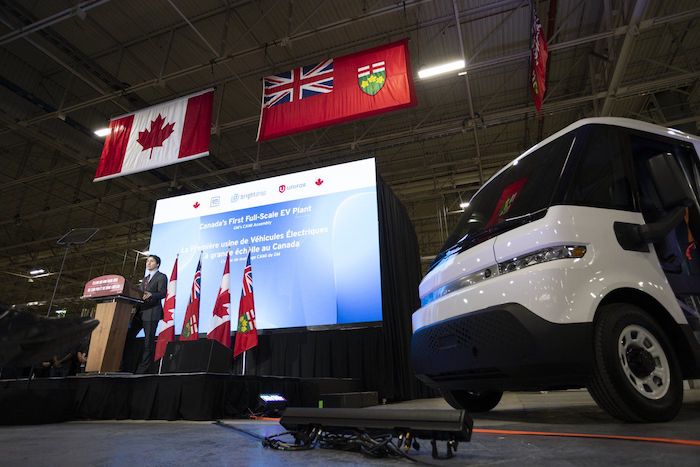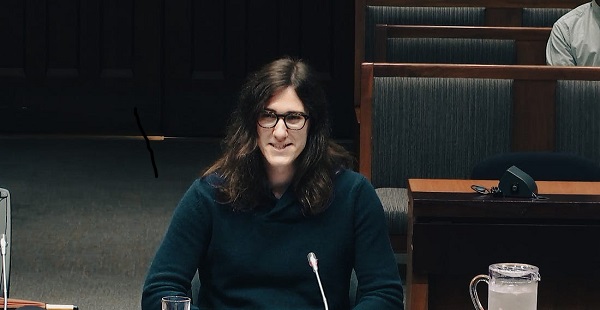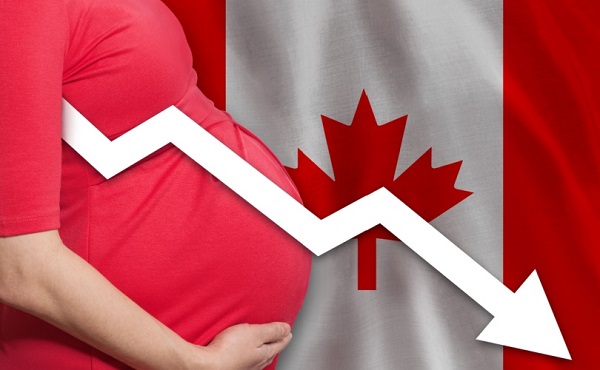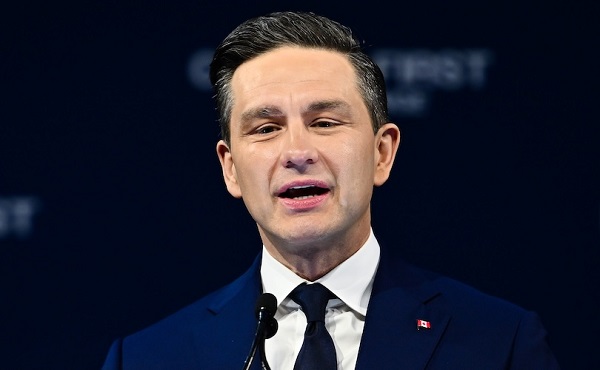Business
Canada moves to mandate electric vehicle sales starting in 2025

By Mia Rabson in Ottawa
One-fifth of all passenger cars, SUVs and trucks sold in Canada in 2026 will need to run on electricity under new regulations Environment Minister Steven Guilbeault is proposing Wednesday.
By 2030, the mandate will hit 60 per cent of all sales and by 2035, every passenger vehicle sold in Canada will need to be electric.
Manufacturers or importers who don’t meet the sales targets could face penalties under the Canadian Environmental Protection Act.
Canada still has a long way to go before approaching the first target in 2025.
In the first six months of this year, electric vehicle sales, including fully-electric and plug-in hybrid vehicles, made up just 7.2 per cent of new car registrations. For all of 2021, the proportion was 5.2 per cent.
Under the draft regulations, to be formally published Dec. 30, the government proposes tracking the sales by issuing credits for vehicle sales.
Fully electric cars and trucks would be worth a bigger credit than plug-in hybrid versions, though the government acknowledges that plug-in hybrids will likely remain in demand in rural and northern areas.
The mandate fulfils a 2021 Liberal election promise. It’s the first major set of regulations to come out of an emissions reduction plan the government published in April.
That plan is Canada’s broad road map toward hitting its goal to reduce greenhouse gas emissions across all sectors to a level in 2030 that is 40 to 45 per cent below what it was in 2005.
Passenger vehicles account for half of all road transportation emissions and about one-tenth of Canada’s total emissions across all sectors.
Before Wednesday’s move, Canada already had targets for electric vehicle sales. But they were not enforceable, and the government wasn’t successfully compelling car companies to ramp up the number of electric vehicles available for sale.
The new targets will be nationwide, though some provinces are already ahead of others.
Quebec and British Columbia already have provincial sales mandates. An analysis released last week by the Canadian Climate Institute concluded that the mandates helped both provinces move well out ahead of the rest of the country on electric-vehicle use.
Anna Kanduth, a senior research associate at the institute, said global supply of zero-emission vehicles is still limited, though it is growing quickly.
“Auto manufacturers are largely prioritizing jurisdictions with some type of sales mandate,” she wrote, adding that places with mandates have much higher rates of zero-emission vehicle adoption and more model choice.
B.C. is leading the field in electric-vehicle sales, which account for almost 15 per cent of all new vehicles registered between January and June. Quebec is in second, at 11.4 per cent of registrations.
There is a steep drop off to third-place Ontario, where only 5.5 per cent of new registrations are for electric vehicles. The number is below four per cent in all other provinces.
This report by The Canadian Press was first published Dec. 21, 2022.
Business
Former Trump Advisor Says US Must Stop UN ‘Net Zero’ Climate Tax On American Ships


From the Daily Caller News Foundation
Later this week the United Nations will hold a vote on a multi-billion climate-change tax targeted squarely at American industry. Without quick and decisive action by the White House, this U.N. tax on fossil fuels will become international law.
This resolution before the International Maritime Organization will impose a carbon tax on cargo and cruise ships that carry $20 trillion of merchandise over international waters. Roughly 80% of the bulkage of world trade is transported by ship.
The resolution is intended to advance the very “net zero” carbon emissions standard that has knee-capped the European economies for years and that American voters have rejected.
This tax is clearly an unnecessary restraint on world trade, thus making all citizens of the world poorer.
It is also an international tax that would be applied to American vessels and, as such, is a dangerous precedent-setting assault on U.S. sovereignty. Since when are American businesses subject to international taxes imposed by the United Nations?
The U.S maritime industry believes the global tax would cost American shippers more than $100 billion over the next seven years if enacted.
Worst of all, if the resolution passes, it will require the retirement of older ships and enable a multi-billion-dollar wealth transfer to China, which has come to dominate shipbuilding in recent years. China STRONGLY supports the tax scheme, even though, ironically, no nation has emitted more pollutants into the atmosphere than they have. Yet WE are getting socked with a tax that indirectly pays for THEIR pollution.
Despite the fact that we pay a disproportionate share of the tax, the U.S. has almost no say on how the revenues are spent. This is the ultimate form of taxation without representation.
Even if the United States chooses not to implement the tax on domestic shipping, it will still be enforced by foreign ports of origin or destination as well as by flag states. As a result, American importers and exporters will be required to pay the tax regardless of domestic policy decisions.
Secretary of State Marco Rubio, Secretary of Energy Chris Wright, and Secretary of Transportation Sean Duffy have jointly stated that America “will not accept any international environmental agreement that unduly or unfairly burdens the United States or our businesses.” They call the financial impact on the U.S. of this global carbon tax “disastrous, with some estimates forecasting global shipping costs increasing as much as 10% or more.”
The U.S. maritime industry complains that although American vessels carry only about 12% of the globally shipped merchandise, U.S. flag vessels would bear almost 20% of this tax. No wonder China and Europe are for it. The EU nations get 17 yes votes to swamp the one no vote out of Washington.
Unfortunately, right now without White House pressure, we could lose this vote because of defections by our allies.
To prevent this tax, the White House should announce a set of retaliation measures. This could include a dollar-for-dollar reduction in U.S. payments to NATO, the U.N., IMF and World Bank.
At a time when financial markets are dealing with trade disputes, the last thing the world — least of all the United States — needs is a United Nations excise tax on trade.
Stephen Moore is co-founder of Unleash Prosperity and a former Trump senior economic advisor.
Business
“Nation Building,” Liberal Style: We’re Fixing a Sewer, You’re Welcome, Canada

Ottawa held a full-blown press conference to announce they unclogged a pipe in Toronto and called it a generational housing strategy.
You probably didn’t hear much about it unless you were watching Canadian state media but this morning, the Liberal government held a press conference in Toronto. It was billed as a “generational investment” in housing. That’s the phrase they used. In reality, it was a sewer project.
Gregor Robertson, the former mayor of Vancouver and now the federal minister of housing and infrastructure, stood beside Toronto Mayor Olivia Chow and a cluster of Liberal MPs to announce that Ottawa is spending $283 million to upgrade the Black Creek trunk sewer line. That’s a pipe. A very old pipe. And according to Robertson, that investment will “unlock” the construction of up to 63,000 new homes in the Downsview area.
If that sounds suspiciously like taking credit for doing your job, maintaining the basic infrastructure cities rely on, that’s because it is. No one has ever accused the Liberals of missing an opportunity to repackage civic maintenance as a national moral crusade. The sewer line is 65 years old. It overflows during storms. It’s been a known problem for decades. Fixing it is not bold housing policy. It’s plumbing.
But the political optics are irresistible. The Trudeau Liberals, now under the leadership of Mark Carney are desperate for a win on housing. Their record is catastrophic. Home prices have doubled. Rents have soared. Entire generations of Canadians have been priced out of ownership and locked into permanent renter status. And the architects of that disaster are now flying around the country handing out ribbon-cutting ceremonies and calling it reform.
Today’s announcement also included the unveiling of the first project under a brand-new federal housing agency, Build Canada Homes. Never heard of it? That’s because it didn’t exist until a few weeks ago. And who’s running it? None other than Ana Bailão a Liberal operative and former Toronto city councillor who spent years helping make the city unaffordable in the first place. Now she’s being rewarded with a cushy federal appointment, tasked with building modular housing and handing out contracts on public land.
And what exactly is Build Canada Homes building? Today, they’re launching 540 homes. Not 63,000… 540. Factory-built units that will be delivered at some undefined point in the future. That’s the big federal breakthrough. A housing crisis affecting millions of Canadians, and Ottawa’s answer is five hundred and forty modular homes in Downsview.
This is the pattern every time. The government breaks something, calls it a crisis, and then demands credit for fixing a fraction of it with your money. The numbers are staggering. According to the Parliamentary Budget Office, Canada needs 3.1 million more homes by 2030 to restore affordability. That means building over 430,000 units per year. Right now, we’re building maybe half that. The backlog gets worse every year. But today, we’re supposed to celebrate because they’re unclogging a sewer and firing up a couple prefab builds on federal land.
No one in the press asked the obvious question: why aren’t private builders constructing the 300,000 units that Toronto has already zoned and approved? Because they can’t. The financing doesn’t work. The cost of materials is too high. Interest rates have crippled developers. And cities like Toronto still impose hundreds of millions of dollars in fees, development charges, and bureaucratic red tape. That’s the real bottleneck. Not the sewer. And here’s what they definitely won’t say out loud: Canada’s housing disaster is not just about supply. It’s about demand, turbocharged by one of the fastest immigration intakes in the Western world. The Bank of Canada has warned repeatedly that immigration targets, set without any link to housing capacity — have blown demand wide open and put relentless upward pressure on rents and home prices.
Mayor Chow admitted it herself, sort of. She said the city has thousands of units ready to build but no takers. And instead of confronting the root causes, monetary policy, taxes, regulatory insanity, the government announces a pilot project and tells you to be grateful. That’s how disconnected they are from reality. They’ve regulated housing out of reach and now they’re posing for photos on a construction site, pretending to be the solution.
And just in case there was any lingering doubt about how deep this failure runs, Statistics Canada released its latest building permit numbers this morning and the trend is exactly what you’d expect in a country where the government makes building homes all but impossible.
The total value of building permits dropped again in August down $139 million to $11.6 billion. Residential permits alone fell 2.4%, driven by steep declines in Ontario and Alberta, the very provinces with the most acute housing needs. Single-family permits fell off a cliff — down more than 10% year-over-year. That’s not a slowdown. That’s a stall.
Meanwhile, British Columbia and Quebec where government intervention is particularly heavy barely managed to offset the damage. The number of new dwellings authorized actually shrank month over month. And this is happening in the middle of a so-called national housing push.
StatsCan didn’t sugarcoat it. They didn’t blame foreign investors or greedy landlords or some phantom market force. They just showed the raw data: Permits are falling. Housing starts are lagging. Builders are retreating.
So let’s just pause here and appreciate the sheer absurdity of what we witnessed. A parade of officials, flanked by branded podiums and tax-funded media handlers, standing in front of a construction site to announce, with straight faces, that they are upgrading a sewer line. And for this, we are told we are “building Canada strong.” Really? That’s the pitch? Fixing basic municipal plumbing is now a nation-building moment?
No! Let’s be clear, you’re not building Canada strong. You’re doing your job. A sewer upgrade in Toronto is not some heroic act of visionary leadership. It’s literally maintenance. It’s what functioning governments are supposed to do, quietly, competently, without a six-camera press choreography and a round of applause from party MPs.
But in Liberal Carney Canada the bar has been lowered so dramatically that simply clearing a permit backlog and patching old infrastructure is treated like a moon landing. They break the system, congratulate themselves for patching one pipe, and expect gratitude.
If you want praise for fixing aging civic infrastructure, something cities used to handle without a national press event, then that tells us everything. It tells us the Liberal government has become so hollow, so addicted to performance politics, that maintenance is now treated as achievement. That’s how far we’ve fallen in just ten years.
They didn’t rebuild a nation. They didn’t launch a housing renaissance. They unclogged a sewer, and are now demanded a standing ovation. And that, in a single image, is modern Liberal Canada: the total collapse of standards, repackaged as progress and sold back to you at full price.
Canadians don’t need more press conferences. They need homes, dignity, and a government that works without constant applause. And if unclogging a pipe is what passes for leadership now — then God help the country.
Subscribe to The Opposition with Dan Knight .
For the full experience, upgrade your subscription.
-

 Alberta1 day ago
Alberta1 day agoFact, fiction, and the pipeline that’s paying Canada’s rent
-

 2025 Federal Election1 day ago
2025 Federal Election1 day agoProtestor Behind ‘Longest Ballot’ Chaos targeting Poilievre pontificates to Commons Committee
-

 Business2 days ago
Business2 days agoUN, Gates Foundation push for digital ID across 50 nations by 2028
-

 Brownstone Institute2 days ago
Brownstone Institute2 days agoTrump Covets the Nobel Peace Prize
-

 Business2 days ago
Business2 days agoTruckers see pay surge as ICE sweeps illegal drivers off U.S. highways
-

 International2 days ago
International2 days agoHamas releases all living hostages under Trump peace plan
-

 Business2 days ago
Business2 days agoNetherlands Seizes Chinese-Owned Chipmaker in Unprecedented Security Move
-

 Business1 day ago
Business1 day agoFinance Titans May Have Found Trojan Horse For ‘Climate Mandates’








